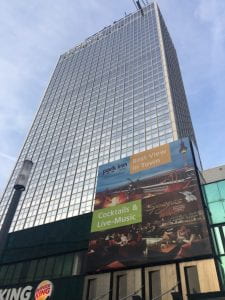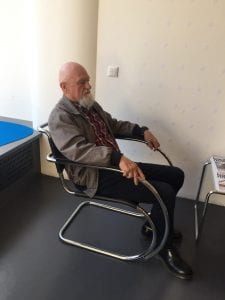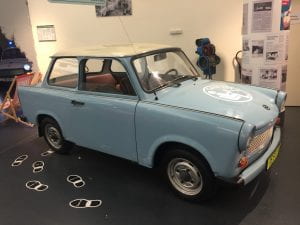
Graham Walton, BA History of Art and Design, recalls his highlight of Level 5.
A trip that involved taking fourteen University of Brighton undergraduates to Berlin was always going to be great fun. The trip, however, was not a holiday and there was also much academic work to be done, including a seminar presentation and an essay.
Students were formed into groups and each took charge of arranging a day and deciding on places to visit. We had a very eclectic mix of degrees on the trip, including Architecture, Digital Music, Graphic Design, History of Art and Design, Fashion and Dress History, and Photography. We stayed in the 40-storey Park Inn hotel, built in the Soviet era, which in itself is a piece of interesting design from the German Democratic Republic (East Germany). The hotel, built in Alexanderplatz, towered above the Berlin Wall.
On the first day of the trip we visited the East Side Gallery, which is basically a large section of the Berlin Wall now turned into an outdoor art gallery. On the way to the gallery we stumbled upon a collective of small art spaces that artists and entrepreneurs can rent, with a lively and relaxed atmosphere.
Our next visit was to the Jewish Museum, which was very moving experience as much of the display artwork related to the Holocaust. The building is concrete and constructed in a disconcerting sloping style. Memorabilia and family photographs of people murdered by the Nazis were displayed behind glass in the corridors. There was also a tall concrete room with a beam of light from the ceiling that clearly related to the feeling of being detained in a concentration camp. In another sculptural space, flattened round metal discs of faces on the floor were designed to be walked over producing an eerie, echoing metallic sound. This visit was very moving and some became appropriately tearful.
There was naturally much interest in the Bauhaus school. Unfortunately the Berlin Bauhaus museum was shut for renovation for the 2019 centenary. There was however a temporary small Bauhaus exhibition, which we visited.
We also visited the Kaiser-Wilhelm-Gedachtniskirche, a church bombed in 1943. A decision had been made that it would be not be rebuilt but instead left as a reminder of war with a new church built alongside. The original church, built at the turn of the beginning of the twentieth century, had a wonderful Arts and Crafts-style ceiling. The new church next door was rather unprepossessing-looking, slightly brutalist from the outside and octagonal in shape, however, once inside, the many beautiful little blue square windows gave a wonderful internal light.
A popular choice was Urban Nature, a graffiti museum exhibiting artwork inspired by Berlin’s graffiti. As graffiti is an anarchic street artform, we felt the museum was really a contemporary art gallery borrowing inspiration from street art; as such there was something incongruous about it.
I felt The Museum of Things was of greater interest to design historians as it showed wonderful late modernist 1950s and 1960s household items. It was interesting to compare West and East German domestic items.
I have a particular interest in Cold War design and visited the Trabi Museum. The Trabant was a small East German car, designed in the early 1960s, which was manufactured until the collapse of the Berlin Wall. Initially it was a good design but it was never fully developed and it fell behind the more sophisticated designs of cars made in West Germany. Trabants featured in the collapse of the Berlin wall when thousands streamed over the border at the collapse of the Soviet empire. I decided to do my presentation on the Trabant.
On the last day we could plan our own time, which gave an opportunity to do research and take pictures of possible items for our presentation and essays. I went to the Stasi Museum, which again was full of wonderful Cold War design items. I also went to the Potsdamer Platz redevelopment as this was my chosen essay subject. This redevelopment was once the biggest building site in Europe, but the results were in my opinion were rather dull. Berlin’s main interest for me is its edginess and its alternative lifestyle not corporate office blocks. Twenty years on these buildings already look dated and not in keeping with the Berlin ethos. Berlin has developed into the ‘start-up’ capital of Germany leaving the Potsdamer Platz development looking rather redundant.
Naturally the trip included much partying in Berlin’s lively nightclub scene, however we also gained much insight into the city’s traumatic history and learned so much about aspects of art and especially twentieth-century design. For future students considering their future module choices, I’d say it is an absolute must. It was a brilliant week.









